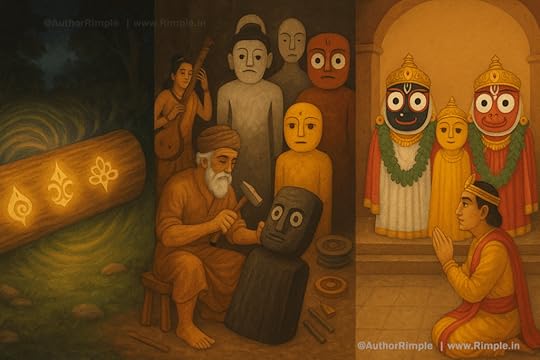BE 4: The First Idols of Jagannath – The Divine Craftsmanship of Vishwakarma
From the silent cave where Neela Madhava vanished, leaving King Indradyumna’s heart heavy with bhakti and tears, we step into a divine moment where the heavens opened to fulfill Shri Krishna’s promise to shine as Bhagwan Jagannath in Kali Yuga. Under the sacred skies of Puri, where the ocean hums and the air sparkles with divine light, the first idols of Jagannathji, Balabhadraji, and Subhadraji were born, their forms woven from sacred wood yet glowing with the eternal love of Shri Krishna. This is a tale of celestial craftsmanship, where every chisel stroke sang of bhakti, painting the vibrant colors of Hinduism—crimson silks, golden ornaments, and emerald garlands—into the heart of every bhakt.
In his despair, King Indradyumna stood on Mount Neela, his eyes fixed on the horizon where the sea kissed the sky. The air was sweet with the scent of lotus flowers, and the breeze carried the soft chant of Vedic hymns from a grand Ashwamedha Yagna he had begun to honor Bhagwan Vishnu. As the sacrificial fires crackled, their golden flames leaping toward the heavens, a celestial voice whispered, “Build a temple, for the divine Darubrahma will come to you.” The king’s heart soared, his tears drying like dew under the sun, as he ordered a magnificent temple to rise on Puri’s shores. The sound of hammers and the fragrance of fresh sandalwood filled the air, while bhakts sang bhajans, their voices blending with the ocean’s roar, creating a symphony of faith.
One dawn, as the sky blushed pink and gold, a sacred neem log—Darubrahma—floated to Puri’s shore, glowing with an otherworldly light. Its surface shimmered like the Yamuna’s waters, marked with divine symbols: a conch, a chakra, and a lotus, each sparkling as if kissed by the gods. The bhakts gasped, their hearts pounding, as they carried the log to the temple, its weight light as a feather yet heavy with divine energy. The scent of neem mingled with incense, and the air hummed with anticipation. This was no ordinary wood—it was the living essence of Shri Krishna’s melted heart, the Brahma Padartha, ready to take form as Bhagwan Jagannath, Balabhadraji, and Subhadraji.
Then came Vishwakarma, the divine architect, disguised as an old carpenter, his eyes twinkling with celestial wisdom. His hands, rough yet gentle, held sacred tools that glowed faintly under the torchlight. In a secluded chamber, the sound of his chisel echoed like a rhythmic prayer, each stroke carving the divine forms with love. The air was thick with the earthy aroma of neem and the soft hum of Naradji’s veena, guiding the sacred work. Vishwakarma shaped Jagannathji’s large, lotus-like eyes, radiant as the full moon, and His smile, warm as a summer dawn. Balabhadraji’s white form emerged, strong like a mountain, holding a plough to protect all. Subhadraji’s golden figure bloomed, her gentle presence like a sister’s embrace. The Sudarshan Chakra, a fiery disc, completed the divine quartet, its glow lighting up the chamber.
When Indradyumna, eager with bhakti, entered before the work was complete, Vishwakarma paused, leaving the idols with no hands or feet—a divine mystery. The king fell to his knees, his heart trembling, but a voice from the heavens, soft as a flute’s melody, declared, “This is My will. These forms, incomplete yet perfect, are the Darubrahma, the eternal Brahman in wood, to love all in Kali Yuga.” The idols, adorned with crimson cloth, emerald garlands, and golden crowns, pulsed with Shri Krishna’s divine heart, their colors reflecting the vibrant unity of Hinduism—where Vaishnava bhakti, tribal love, and Vedic wisdom blend as one.

To capture this divine creation, let us turn to a Sanskrit verse from the Skanda Purana, sung by bhakts in Puri’s sacred halls:
Sanskrit Verse (Devanagari):
दारुब्रह्म स्वरूपेण विश्वनाथः प्रकाशति।
भक्तानां हृदये दीप्तं सर्वं प्रेमेण संनादति॥
Poetic English Translation:
In Darubrahma’s sacred form, the World’s Lord brightly glows,
In bhakts’ hearts, His love does shine, where boundless mercy flows.
Meaning of the Verse:
This verse celebrates Bhagwan Jagannath as the divine Darubrahma, the wooden form radiant with the eternal Brahman. His presence lights up the hearts of bhakts, filling them with love and mercy, a beacon of hope in Kali Yuga that unites all in bhakti’s vibrant embrace.
As the idols were placed on the temple’s Ratnabedi throne, their lotus eyes sparkled, and the air filled with the scent of jasmine and the sound of conch shells. Bhakts wept with joy, feeling Jagannathji’s gaze, Balabhadraji’s strength, and Subhadraji’s warmth envelop them. In Kali Yuga, these idols, born from Vishwakarma’s divine hands, stand as a promise of Shri Krishna’s love, their colors—crimson, gold, white—calling all to bhakti. But how did this sacred temple become the heart of Puri’s spiritual legacy? The tale awaits, where stone and spirit unite to sing of Jagannathji’s eternal glory.
Also Read:
BE 3: The Quest for Neela Madhava – The Precursor to Jagannath
BE 2: Pauranic Origins – Shri Krishna’s Melting Heart and the Birth of Jagannath’s Form
BE 1: The Sacred Dawn of Pandharpur – Pauranic Beginnings of Bhagwan Vitthal and Devi Rukmini
BE 2: The Historical Tapestry of Pandharpur Wari – A Journey Through Time
BE 1: The Sacred Dawn of Pandharpur – Pauranic Beginnings of Bhagwan Vitthal and Devi Rukmini
Monsoon Kisses and Cutting Chai, Full of Forever
Food is Never Just Food
India’s Hydro-Diplomacy Masterstroke: Crippling Pakistan with Water Strategy Post-Pahalgam Attack
Actions Taken by India Against Pakistan Since the Pahalgam Attack (April 22, 2025)



